Western demonology

Demonology (from other Greek, that is, the deity, spirit, genius, and from other Greek, that is, word, reasoning, science) is the common name for dissimilar myths about demons. The name is used by analogy with modern scientific directions. The main directions in demonology are usually the study of demons, the description of the demons' behavior, the description of the rites of calling demons, fighting them, subordinating and controlling their forces, etc. Demonology accompanies many religious and mystical traditions, while the religions themselves can relate to demonology And demons sharply negative. The term can be used both in occultism and in scientific and historical works. The branch of theology, which studies the supernatural, natureless deity. Demonology is often manifested in folklore, fiction, mythology, magic, etc. The demonologist is an occultist who studies demonology, demons, evil spirits, their machinations against man.
The science of demonology is rooted in antiquity. We collected a small part of the description and pictures for public information purposes. Comment and argue is not undertaken because it is not a guru. Everyone perceives information as he sees fit and uses it as he pleases.
God, save us all! V
1. Abraxas

The creature with the cock's head is the Hellenistic god Abraxax (or Abraxas), who was often called the Demiurge, IAO. It is accompanied by solar symbols: the cock every morning announcing the return of the Sun is a symbol of rebirth, and the whip with the shield, with which it was most often depicted, symbolizes the heat of the midday Sun. Abrasaksa was often portrayed on magical amulets and gems of the Hellenistic era; The Alexandrian gnostic Basilides called Abraxax "the Great Ruler of 365 Heaven" and the creator of the physical universe. Abrasaks belongs to the category of serpentine Solar deities, which indicates a pronounced aspect of this god. Thus, Abraxax, the solar cock, the creator of this World, symbolizes the productive power of the Sun. But, unlike Christ, he is not directly connected with the Higher Aspect of the Solar Logos-Creator.
.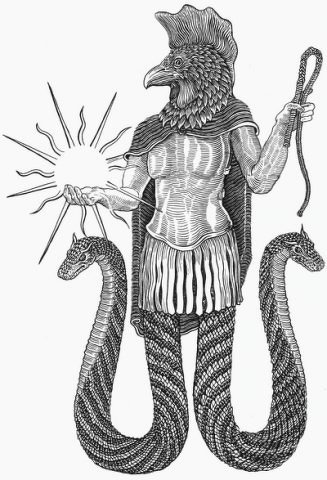
La. For Christian writers it was common to reduce gods and goddesses of pagan religions and heretical sects to the level of demons. In fact, the deities of heretical religions served as the main source for Christian demons.
2. Agalyrept - AQALIAREPT
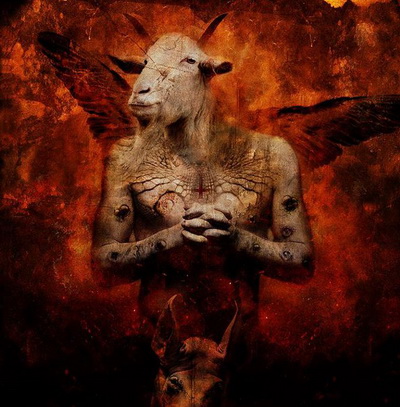
Agaliorapt reports directly to Lucifer. Controls Europe and Asia Minor. Agaliorept has the ability to disclose the secrets of the judicial and executive power of any state in the world, governs the past and the future. He has access to the most intimate secrets, he sows enmity and mistrust between people. He directly subordinates three powerful demons - Buer, Guzoin and Botis), as well as the mighty spirit of Eelogop, who controls the waters. Agaliorept The general-secretary of Ada, commander of the Second legion of the infernal army, and portrayed as an adult with drooping mustaches.

2a.
3. Alocer - ALOCER
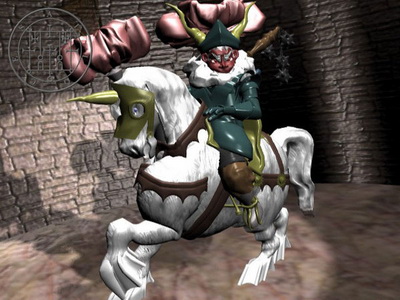
Demon Alocer (or else Allotzer, Allots, Alokas) is the fifty-second demon described by MacGregor Mathers and Alistair Crowley in his edition of Goetia. "He is a prince, great, omnipotent and mighty, appearing as a Soldier (or Warrior) riding a Great horse. His face is like a lion, very red, with burning eyes. His voice was hoarse and loud. His service is to teach the art of astronomy and all humanities. He brings with him good "acquaintances", and also rules 36 legions of spirits. "
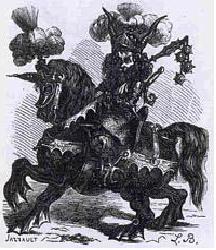
3a.
4.Amdusias - AMDUSIAS
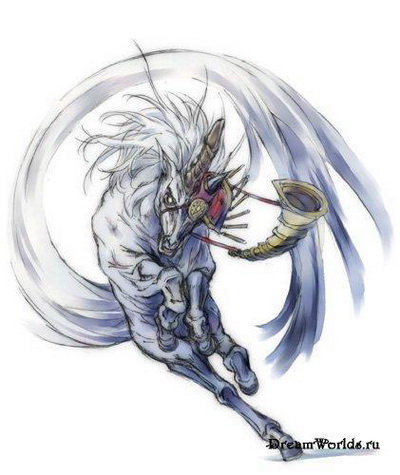
Amdusias (also Amdusias and Amdukias) is one of the demons of hell described in "Goetia," one of the handwritten grimoires, also known as "Lemegeton" or "Lesser Key of Solomon." Goetia states this demon: "He Prince, great and mighty, appearing in the beginning in the form of the Unicorn, but at the request of the defender he stands before him in the form of a human being, and, at the same time, but not immediately, pipes and many other musical instruments are heard. He also makes the trees bow and bend at the will of the caller. He gives excellent "acquaintances" and manages 29 legions of spirits. " In the illustrations of Collin de Plancie on the head of Amdusias crown, to show that he is the prince of hell. It is depicted with a horse's head, as unicorns usually appear in the form of a horse. Two pipes lie on the ground, and the third hangs on his shoulder.
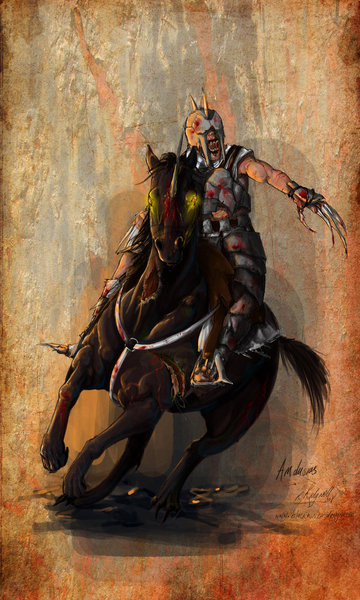
4a. He can be considered the patron of modern rock music in the style of "heavy metal" because he has the ability to produce terrible clanking music, and if so, then we must admit that he is still doing his job well.
5.Ammit - AMMYG
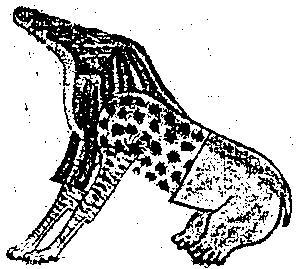
One of the most terrible Egyptian demons is Ammit - a monster with a hippopotamus, anterior part of a lion and a crocodile head. The Egyptians were very afraid of all these animals, because they ate people. Ammit is a female demon, known as the devourer of the dead and the inhabitant of Amenty, the place where the sun sets. The Egyptians called their cemeteries on the west bank of the Nile by the Amenta. The purpose of Ammity was to wait at the Palace of Justice, while on the Great Scales one heart was laid on the heart of a recently deceased person, and on the other - the Maat pen. God Toth recorded the result. It was necessary that the scales showed the same weight, and the scales arrows lay horizontally (see Budge, The Book of the Dead, p. 238). The soul, whose heart passed the test, gave shelter on the Field of offerings ...
6.Avdras - ATTORAS
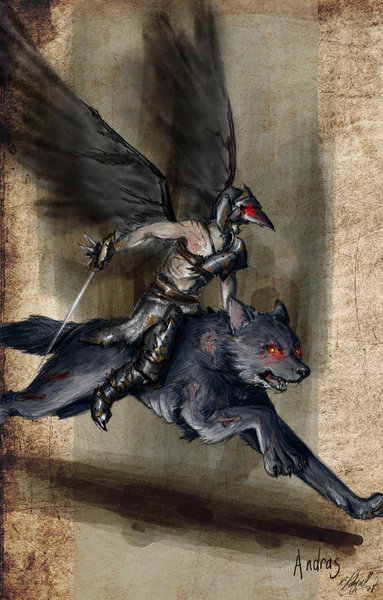
The "Goetia" about the demon Andras says: "He is a great marquis who is in the form of an angel with the head of a black night-raven riding a mighty Black wolf, raising a sharp, bright sword in his hand. His service is to sow disagreements. If the caller is not careful, Andras will kill him and the others present. He manages 30 legions of spirits. "To understand this description, some explanations will be useful. Under the night crow means an owl. Black wolves were once quite common in Europe. Both the wolf and the owl are considered animals representing evil. The magician who performs the demon call is called "exorcist" in the English translation "Goetia", as in the manuscript edition. Here we will not use the term "exorcist" in view of the fact that in our day only a person who performs the expulsion of demons from a person is designated by such a term.
7.Apollion - Apollyon

Cornelius Agrippa equated this demon with Abaddon and considered him the ruler of the lower shadow of the sphere of the planet Venus, which is the Sefira Netzach on the Kabbalistic tree. "The seventh house is owned by furies, who are the forces of evil, disagreements, wars and devastations, whose prince in Revelations is called in Greek Apollon, in Hebrew - Avaddon, that is, destroying and devastating." Agrippa quotes the biblical verses - Revelation 9:11, which read: "With a king over them, they had an angel of the abyss; His name is Hebrew Avaddon, and in Greek Apollo. " In the Old Testament the name Abaddon is used for the place where the dead are placed. Literally it means destruction or death. Apollo is the Greek equivalent of this word. The demons that Abaddon presides over appear at the sounds of the next (fifth) ship's pipe at the time of the Last Judgment. Demons are in the form of locusts, which "is like horses prepared for war: and on her head, like crowns, like gold, her faces are like human faces; And her hair is like the hair of a woman, and her teeth are like those of lions; On it were armor, as if armor iron, and the noise from her wings is like the sound of chariots, when many horses run to war ... "
8. Asmodey - ASMODAI

In regard to this demon, whose name is also written by Asmodeus, "Goetia" writes the following: "He is the Great King, strong and powerful. He is with three heads, of which the first belongs to a bull, the second to a man, and the third is like a ram. He also has a snake's tail, and tongues of flame emanate from his mouth. His feet are webbed like a goose's. He sits on a hellish dragon and holds a spear with a banner in his hand. Asmodeus is the first among the elect who are under the authority of Amaimon, he goes ahead of all. "" If the magician wants to call him, it's better to do it outside the house, and let him keep on his feet all the time without a headdress, otherwise, if he He will put it on, Amamon will deceive him and call back all his actions. But if the caller sees Asmodeus in the above-named appearance, he should ask his name, saying: "Are you Asmodeus?" - and he will not deny it and will gradually bow to the ground. " "He gives a ring of virtues, teaches arithmetic, astronomy, geometry and absolutely all crafts. He gives truthful and complete answers to all questions. He makes a person invisible. He shows the place where the treasure is hidden and guards it. He, among the legions of Amaimon, is ruled by 72 legions of the spirits of hell. "
9. ASTAROT - ASTAROT
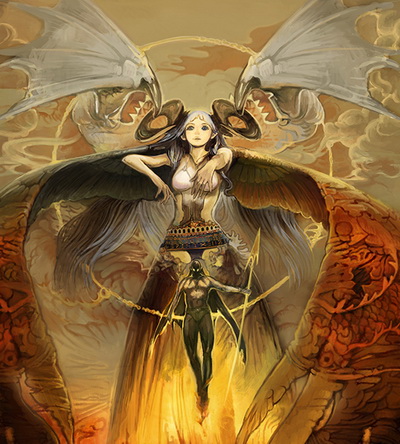
The name of this demon is derived from Ashtaroth. The "Red Dragon" says that he is the great prince of hell and is depicted with his tongue hanging out, as if mimicking everyone and everything. Probably, it can be identified with Astara - the ancient Semitic astral deity, revered on a par with the goddess Astarte, as her formidable husband. In Ugaritic myths, he is one of the contenders for power over the world. Being opposed to the god Balu, Astaroth is in Ugarit the embodiment of the evil principle; His usual epithet: "terrible." His image was honored for a long time in Ancient Yemen, where he was the god of war, a formidable and powerful and at the same time a defender of God, the guardian of houses and tombs, protecting them from everything damaging and destroying. His divine wife Astarte was highly venerated in Assyro-Babylonian mythology, in Ancient Egypt she was identified with the goddess of fertility Ishtar, who was perceived as the mistress of horses and chariots, the goddess of battles and probably associated with water and water elements. Astarte was also highly revered in Carthage and in Cyprus, where she was even identified with the goddess of love Aphrodite. The images of Astarte in the form of a naked horseman shooting from a bow are known. E. Waite identifies the image of this demon with the Olympic spirit of Tuesday.
10. Ashtaroth - ASTAROTH
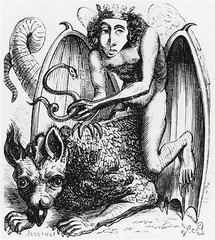
The name Ashtaroth is probably derived from the name of the Canaanite goddess of Astarte fertility, revered by the Philistines, and also in Sidon. For the ancient Jews, she was the wife of Baal and was identified with the planet Venus when she shone with the evening star in the western sky. She was one of the three Canaanite goddesses: Anat, Ashtart and Asher. Ashtarte may have been called by Jewish women during childbirth. As often happens, there is nothing like the character of the goddess Astarte and the demon Ashtaroth, who is described as follows in the "Goetia": "He is a great and mighty prince who appears in the form of a fallen angel riding a hellish beast like a dragon and holding in the right Hand viper. In no case should you let him close to you, otherwise he will do harm with his fetid breath. Therefore, the magician must keep a magic ring in front of him that will protect him. He gives truthful answers to questions about the past, present and future, and can also reveal all the secrets. He will deliberately tell how the spirits have fallen, and will reveal the cause of their own fall. He can make a person extremely knowledgeable in all humanities. He rules 40 legions of spirits. " The magic ring was the standard tool of the magician since the Middle Ages and the Renaissance. He is described and illustrated by the most famous of all grimoires, "Goetia". King Solomon used his own ring to seal the bronze vessel, where he planted all the demons that participated in the building of the Temple. Therefore, the ring is very important. In magic, originating from Solomon.
11. AZAZEL - AZAZEL
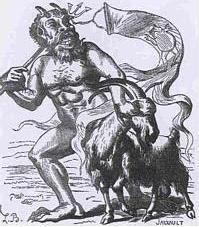
Azazel is a famous desert demon, worthy of mention in the Old Testament (see Leviticus 16: 8). In the Kabbalistic text The Zohar and Enoch Azazel is one of the angels cast from heaven for their connection with mortal women. Probably, it can be identified with Hellenic Prometheus: he teaches people magic, weapons business and cosmetics. "And Azazel taught people to make swords and knives and shields and breastplates and discovered for them the metals and the art of processing them, and bracelets, and ornaments, and the use of antimony, and tinting eyelashes, showed all kinds of precious stones and all the coloring compositions" (book Enoch 8: 1). In Milton's "Lost Paradise," a demon named Azazil is the standard bearer of all the powers of hell. The Qur'an states that Azazil was cast from heaven for refusing to worship God. He said: "Why should the son of fire fall before the son of clay?" Azazel and Azazil are probably the same demon, although, as already said, the similarity of names does not at all mean the identity of demons. The scapegoat on whose head it was customary to lay all the sins of Israel, the ancient Jews were driven out into the wilderness for a reason, namely, as a sacrifice to Azazel. In the translation of the Bible by King James, the name Azazel was replaced by the word "scapegoat". The value of the name is not known with accuracy. Most Bible scholars believe that this is the name of the demon, but the great Jewish scholar Rashi claimed that this is the name of the mountain with a precipice, implying that the scapegoat was thrown off the cliff as a sacrifice. "If you, the reader, are able to understand the mystery of what is after the word" Azazel, "you will also understand his secret and the secret of his name. For there is much in the Scripture that is analogous to him, and I will reveal to you a part of this mystery by a hint, and when you pass by 33, you will recognize it, "wrote the famous poet and philosopher Ibn Ezra (1092-1167). HP Blavatsky sheds light on Azazel's secret: "So the Zohar says that the Ishins, the beautiful B'ne Aleim (ie, the Sons of God), were innocent, but mixed with mortal people, because they were sent for this purpose to the ground.
12. Aziel-AZIEL
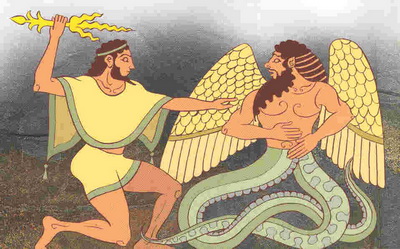
Aziel is the keeper of hidden treasures. His three heads and snake-like fingers indicate a connection with the three-faced goddess Hecate, the Greek god of sorcery and the underworld. The demon is portrayed with a beard, but has a female torso with breasts, a narrow waist and broad hips. This indicates that Aziel is a two-faced creature. His snake-like legs, ending with a fish tail, connect him with snake-monsters of depths, for example, Leviathan. It is possible that his name is derived from the name of the fallen angel Azela, one of the princes of the Watchmen, who descended to earth to mate with mortal women. Azael is mentioned in the Jewish book of Enoch.
13. Bael - BAEL
Bael or Baell is noteworthy in that the "Goetia" is the first of seventy-two demons. Collin de Planci identified him with the biblical deity Baal, changing the spelling of the demon's name to coincide with the name of the deity, but as already noted, the similarity of names does not always indicate identity. The word "ba'al" means "God." The ancient Jews revered Baal in elevated places in the form of a phallic stone called massebah, probably the ritual was accompanied by copulation. He was the god of fertility, and, apparently, the name of the demon of Belfegor happened - one of the manifestations was Baal-Peor (Numbers 25: 3). Regarding the demon Bael in the "Goetia" says the following: "The first main spirit, ruling in the east, is called Bael. He makes you invisible. He rules 66 legions of hell-spirits. He appears in various forms, sometimes as a cat, sometimes as a toad, and sometimes in a human form. Sometimes it appears in all forms at once. He speaks in a hoarse voice. " Baphomet was the idol, who was supposedly worshiped by the knights of the Knights Templar. The original task of the order was to protect the life and property of Christian pilgrims traveling to the Holy Land and back. The existence of demonoplonism was discovered in 1307 during the interrogation of the knights, when they were accused by the King of France Philip IV of heresy. Twelve of the 231 interrogated knights confessed to the existence of an idol, which they described in different ways and contradictory. It was said that it was a bronze head with a long beard and sparkling eyes, or a human skull, or a painted human image, or a gilded figure of wood or metal, or a head with three faces, or a head painted on one side in black, on the other - White, or bearded silver-headed idol with four legs: two in front and two behind.
14. Beelzebub - BEELZEBUB
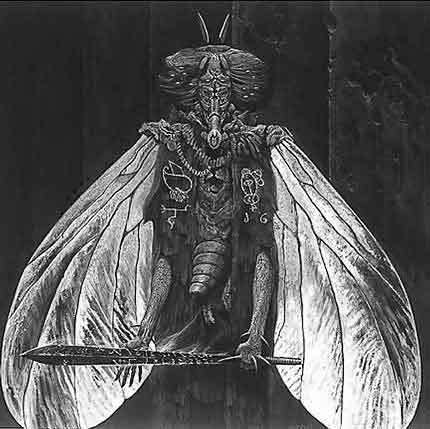
Beelzebub is the prince of hell, whose name is usually translated as "the lord of the flies" (beelzeboub), but which, probably, should be translated as "the master of the earth" (beelzeboul). He is one of the oldest and most famous demonic figures, ascending to the local deity of the city of the Philistines, Akkaro-nu, which is mentioned in the Old Testament. "And Achaea fell through the bars from his upper chamber, which is in Samaria, and fell sick. And he sent messengers, and said to them: Go, ask Baalzebub, the goddess of Akbaron: Am I going to recover from this disease? "(2 Kings 1: 2). Obviously, Beelzebub had power over disease, which could explain the generally accepted version of his name. Flies fly to the corpses of the dead and carry the disease to the living. In the Bible, to the priests of Beelzebub in Ekron (where his cult existed), ambassadors arrive, so that by means of divination one can know whether a person will recover (Book 2: 2). There are archaeological finds depicting flies, apparently dedicated to this deity. According to some, this was the desire to humiliate Satan by bringing him down to the degree of a miserable "God of flies". This tendency is even clearer in the case of another philological interpretation of the word under consideration - the interpretation by which Beelzebub means "god of manure" or any impurity and dirt. He was considered the main culprit of the agonizing disease of the demoniacs, who usually withdrew from society into unclean places (cemeteries, etc.). The Gospels tell us that the Pharisees and scribes called Jesus Christ Beelzebub or claimed "that he cast out demons by the power of Beelzebub, the prince of demons." According to the vision of the obsessed Catholic nun, Madeleine's sister from Aix-en-Provence, this demon is none other than the ruler of the devil "Beelzebub was the prince of the Seraphim," it was written down from her words, "the most important after Lucifer." All the princes, that is, the rulers of the nine orders of angels fell, the first three fell from the Order of the Seraphim, namely Lucifer, Beelzebub and Leviathan, and all of them "Sister Madeleine further reports that the service of Beelzebub lies in the temptation of people by the sin of pride and that St. Francis of Assisi is his heavenly enemy." The great scientist, philosopher and magician of the Renaissance, Cornelius Agrippa, placed Beelzebub among the demonic Order of the False Gods, whose place , In his opinion, in the lower reflection of the Sephira Keter: "There are some theological schools," he wrote, "which distribute evil spirits to nine degrees, as opposed to the nine orders of angels. Consequently, the first of these are those called False gods and who, when usurping the name of God, will be revered as gods, demanding sacrifice and worship. Like the Devil who said to Christ: "I will give all these things to You, if you fall, you will worship me," revealing to him all the kingdoms of the world; And their prince is he who said: "I will ascend above the clouds and will be like the Highest, and who, therefore, is called Beelzebub, that is, the ancient god." This, it seems, puts Beelzebub even higher than Lucifer. The head of the Golden Dawn Magical Society, S.L. MacGregor Mathers, assigned Beelzebub a place in the second demonic order, in the sphere of Chokm, under Satan and Moloch, but above Lucifer (see "Disclosed Kabbalah," tab IV). All these systems of associations are hypothetical, and none of them should be taken blindly, as the highest authoritative source. The only thing that can be said with certainty is that Beelzebub on the hierarchical ladder of hell is very high.
15. BELIAL - BELIAL
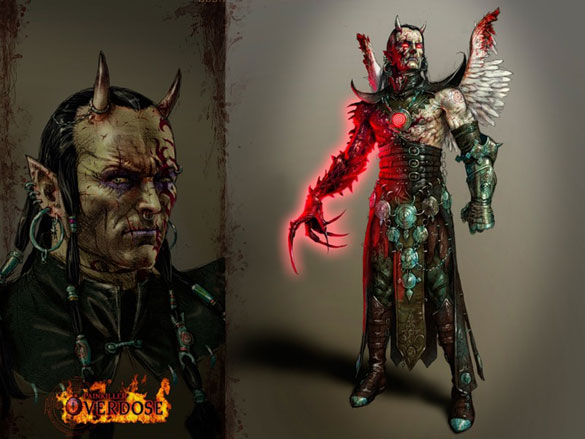
A few demons write books and legends, but Belial received more attention than any other inhabitant of hell, not counting Lucifer himself. In "Goetia" it is stated that Belial is one of the four demons locked in a copper vessel by the magical seal of King Soloman (they say that the other three are Ticket, Asmodeus and Gaap). Reginald Scott in "Discoverie of Witchcraft" tells about Beliala the following, which is clearly taken from Johann Virus's "Pseudomonarchia daemonum". "Some say that King Belial was created immediately after Lucifer, and therefore is considered the father and seducer of the fallen angels. Because he fell first among the more worthy and wise who went before Michael and other heavenly angels ... "Belial, Belial, Beliar, Veliar - in the Bible there is a demonic being, a spirit of non-being, debauchery, lies and destruction.
16. Belferegor - BELPHEQOR
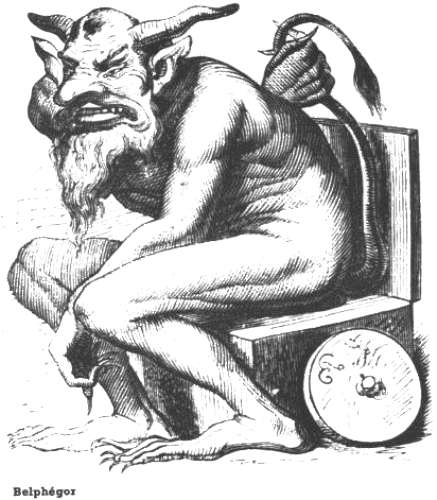
Belfegor - a demon of witty discoveries and inventions. His name seems to be derived from the distorted biblical Baal-Peor, the idol worshiped by the Israelites in Shitgim. This worship could be accompanied by sexual rituals with the "daughters of Moab", and this suggests that the Baal-Peor was the god of fertility. As usual, there is no connection between the characters of the demon of Belfegor and the deity of Baal-Peor, although the name of the demon came from the name of God. Mighty Demon of sex, assistant Belial.
17. Belzebut - BELZEBUT
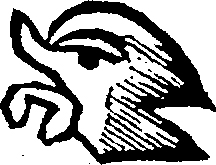
One of the many younger demons is Bellebut. There are countless such little-known demonic beings. The name of this demon, no doubt, comes from Beelzebub, but that does not mean that they have the same character. In the grimoire, known as "Le veritable dragon rouge", Belzebut is described as the prince of hell. His profile is hawkish, probably to show that he is the prince of the air. AE White associated the above portrait of Belzebut with Betor, the Olympic spirit of Thursday and the planet Jupiter.
18. BUER - BUER
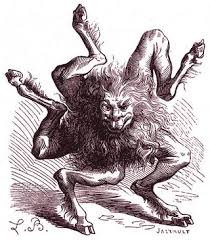
The description of Buer given in Goetia can be incomplete. "He appears in Sagittarius, and this is his appearance when the sun is in this constellation. He teaches philosophy, both spiritual and natural, logic, as well as the virtues of all herbs and plants. He treats a person all mental disorders and gives good "acquaintances". He controls 50 legions of spirits. " Collin de Planci represented Buer in the form of a lion's head, surrounded, like the spokes of a wheel, with five legs with hooves so that he could roll on the ground. But probably the description of this demon in "Goetia" means that Buer resembles the symbol of the zodiac sign Sagittarius, that is, the centaur with the bow in his hands.
19. Cassiel - CASSIEL
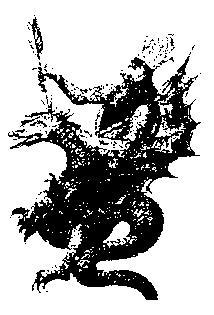
Cassiel, the ruling spirit of the Sabbath, in Barrett's Magus, is clearly demonic. Strictly speaking, Cassiel is not a demon of hell, but the ruling spirit of the Sabbath. The magical actions falling under his authority are carried out on a Saturday, and in order to ensure their successful completion, his spirit is called forth. In Western magic, the line dividing spirits and demons is always very thin, as shown by Cassiel's illustration of "Magus" by Francis Barrett. Physically, nothing distinguishes Cassiel from the dozens of demons of hell described in "Goetia". He is depicted as a bearded king with wings and scaly skin, riding a winged dragon, with an arrow in his right hand. In the Fourth Book of Occult Philosophy, the grimoire, falsely attributed to Cornelius Agrippa, Cassiel is described as "a bearded king riding a dragon." Francis Barrett, with respect to the Sabbath spirits, maintained that "their nature is to sow discord, hatred, evil thoughts and intentions, to permit the killing and maiming of every member." This is a demonic enough demeanor to unmistakably assign Cassiel to demons for all practical purposes. Barrett adds an interesting footnote about the royal appearance of this demon. "Those spirits that appear in the form of kings are much more dignified than those of the lower type, and those who appear in the guise of a person are superior in power and might to the animals that receive the species. The latter, in turn, exceed the appearing in the form of trees, tools, etc. Therefore, the might and power of the spirit can be judged by a noble and worthy appearance. "
20. Kerber (Cerberus) - CERBERUS
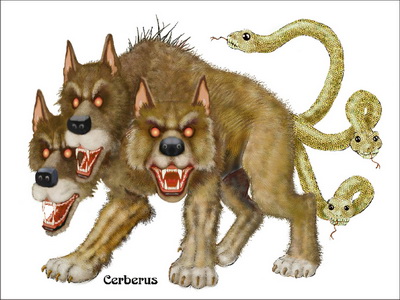
Not all demons look like a person. Cerberus is a Greek dog demon who faithfully protects an indestructible gate into the underworld, so that the souls of the dead can not escape back to the sun-drenched surface of the earth, and also that the living can not freely enter and leave Tartarus. He has three heads and a mane of snakes. In its earliest form Cerberus had fifty heads, but later there were only three, which clearly did not work, because Orpheus, Hercules, Odysseus and later Dante passed him very successfully.
21. Dagon - DAQOW

Dagon is the deity of the Philistines, who is mentioned in the Old Testament in connection with the Ark of Consent. The Philistines placed the captured ark in the temple of Dagon in Ashdod in front of the statue of God. The next morning they found the statue lying face down on the floor. They again installed it, but in the morning the statue again lay on the floor of the temple, this time with a broken head and hands. Dagon was a Semitic god, accepted by the Philistines after the invasion of the Canaanites and so important God that after the Philistines repulsed the Ark from the Israelites, they immediately erected his temple there. Dagon (or Dagan) was revered in Mesopotamia, in Ur in 2,500 BC His cult was popular with the Assyrians. It is possible that he was born as a god of vegetation and gradually evolved into a god of thunderstorms. The Hebrew name Dagon means "Big Fish". This god was differently described in fish guise and therefore sometimes identified with Poseidon. Dagon - the chief baker of the princes of hell, and we can only guess about their culinary preferences.
22. Eurynom - EURYNOME
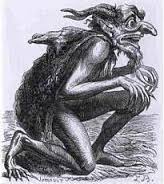
In the Pelasian version of the Greek myth of the creation of the world, Eurinom is the name of the original mother of the gods and the dancing creator of the universe, who rules on Olympus with his son and husband, the titan Office, shaped like a great serpent. The name of Eurynom means "far wandering". In the form of a dove, she laid an egg containing everything in the universe. When Ophion twisted around the egg seven times, it broke up in two and freed the sun, the moon, planets, stars, mountains, rivers and living things. There is no explicit connection between the supreme creature goddess and the grotesque male demon, illustrated in the "Dictionnaire Infernal" of Koshen de Plane and, 1863. Infernal "Planci. Often only the name of the pagan god served as the basis for the demon in grimoires, and in most cases this name was distorted. Here the Greek name remained untouched, but the whole meaning of the goddess was lost.
23. FLOROS - FLAUROS

The Hell demon Floros (also known as Hoare, Horace, Havres) is the sixty-fourth demon described in "Goetia". "He is a great prince and first appears as a powerful, terrible and powerful leopard, but after a while, on the orders of the defiant, he assumes the appearance of a man with burning, fiery eyes and a terrible expression on his face. He gives truthful answers to all questions about the past, present and future. But if he does not stay in the magical triangle, he will lie about all these things and deceive the defender in everything that concerns such and such a thing. In the end, he will speak about the creation of the world and about the divine essence, and about how he fell and other spirits. He will destroy and burn the enemies of the defender, if he desires it.
24. FORCAS FORCAS
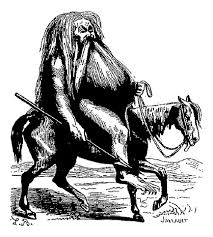
The demon Forekas or Fourcas is described in "Goetia" as follows: "He is a knight and is in the form of a cruel old man with a long beard and a gray head, riding on a light horse and with a sharp weapon in his hand. His service is to study the art of philosophy, astrology, rhetoric, palmistry and pyromancy in all their details and to the fullest. Under his authority are 20 legions of spirits. " Chiromancy or fortune-telling is the art of predicting the future along the lines of the palm. Pyromancy is a prophecy of flame. Ancient age was often associated with magic with secret knowledge. For example, the ancient god Saturn controls difficult studies and dark secrets.
25. Harpy - HARPY
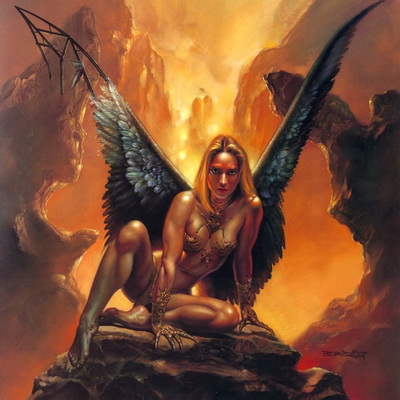
Harpies (from harpyiae: abductors, robbers or intruders) were, according to Gessiod, the daughters of Tavmant and the oceans of Electra. They were called Okipeta and Aella. Hesiod describes them in his Theogony: "Aella and Occipet with beautiful hair that fly on their quick wings, like birds or the breath of the wind; They throw themselves high. " Later authors called them differently: Aellopa, Nikotoja, Okitoya, Kaleno, Ahloy, Podarge and Kelayno. They say that their names mean storm winds. It is in this quality of a personified storm wind that they are described by Homer when they abducted three daughters of King Fandaria to give to the service of Eriniyam (Furiyam). Their usual service is to bring criminals to the Furies for punishment. According to legend, they lived in a cave in Crete ...
26. Incubus, succubus - INCUBUS, SUCCUBUS
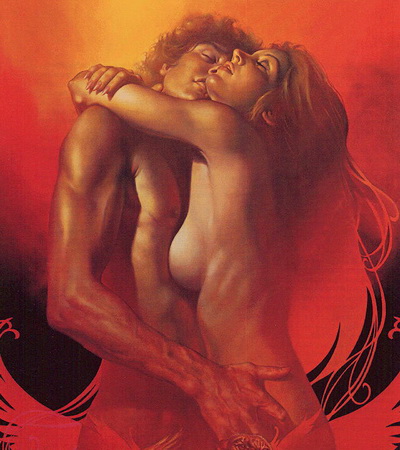
The incubus is one of the demons that embodies the whole class of beings - the male spirits of lust. The name comes from the Latin incubare (lie on something, lie down, weigh heavily). According to the beliefs, when the Incubus came to a sleeping woman and owl-bought with her, she had nightmares and it was difficult to breathe. It was believed that the Incubus sits on her chest or, in some cases, on her face.

26a. This feeling of heaviness on the chest is characteristic not only of the incubus, but also of their female equivalents, the succubus demons who visit sleeping men for the purpose of sexual contact. This sense is very clear, clear and real and has nothing to do with sleep, although it is usually felt for a short period after awakening, when consciousness returns. Weight is not always localized on the chest, at times it can be felt on the face, stomach and legs.

26b. By effort of will it is possible to drive away the demon, and then pressure weakens. Sometimes a demon does not want to leave his place on his chest, stomach, groin and thighs. In this case, this sensation lasts about thirty seconds after awakening, when consciousness has long returned. Weight is removed unexpectedly and palpably. The feeling at the same time is exactly the same when a soft load is lifted from the body. You can actually feel the feeling of something rising and retreating.
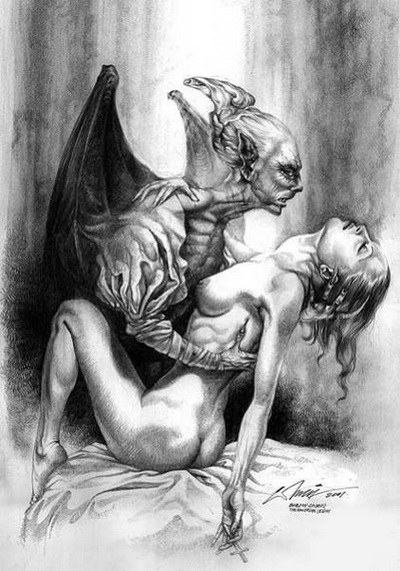
26c. Sometimes you can see the demon as a translucent, obscure form pressing on the chest, it resembles a light shadow in the air, has dimensions and mass, but no specific features. However, you can clearly see the demon in a nightmare during his visit, and you can communicate with him. A visit of an in-cubus or succubus does not always bring a dream, and dreams do not always have a pronounced sexual character throughout their entire length. When such a dream happens, often there is a feeling of rapid ejaculation, and at the same time the weight of the demon on the chest is felt. A natural reaction to this is to make yourself wake up, while the dream and the feeling of a crushing load terminate, but not immediately.

26e. These demons get a kind of food or pleasure from the sexual energy of a person. They have the ability to invade our dreams, imitating their characters, and manipulating the plot of sleep to channel it into a sexual channel. So they feed on our sexual energy. They usually depict people we know and sometimes do not know, so that we interact with them without fear (because from a strong fear a person wakes up). However, from time to time, they immediately appear in a dream and show physical characteristics that can be called inhuman or demonic. As a rule, it causes an intuitive reaction of fear or disgust and breaks off sleep. In fact, there is nothing dangerous in visiting incubuses or succubuses, however frequent visits can cause overwork. Some people who have no business with spirits may be afraid of the inhuman appearance that these spirits sometimes take. Some incubus and succubus deliberately take on an awful appearance to cause strong fear or disgust, probably because they like the "taste" of these emotions mixed with sexual energy. One effective way to stop visiting incubus and succubus is to reach close, loving relationships with a familiar spirit, and then ask him not to let other spirits interfere during your sleep. A familiar spirit will serve as a mental bodyguard, not letting other spirits bother you. You can and do not follow this method, as visiting incubus or succubus can be quite entertaining.
27. Lucifer - LUCIFER
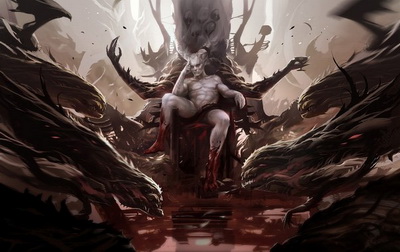
The name Lucifer means "light bearer", "carrying light." This is the name of the morning star, i. Venus; The fathers of the church, this demon, "son of the dawn", is the designation of the devil. This demon was originally a noble and powerful angel, but raised an uprising in the sky against the power of God. For the sin of insubordination, Lucifer was cast into the underworld with the other angels who supported him in the war in heaven. "How did you fall from the sky, Dawn, the son of the dawn! Crashed on the ground, trampling on the peoples. And he said in his heart: "I will ascend to heaven, I will raise my throne above the stars of God and I will sit on the mountain in the assembly of the gods, on the edge of the north, I will ascend to the heights of the clouds ...". In the fallen state his name became Satan. In the Christian tradition, this is the name of a proud and impotent imitator to that light that constitutes the mystical "glory" of the deity. The romantic image of Lucifer was created by the English poet Milton in the epic poem "Paradise Lost."
28. Mammon - MAMMYUI
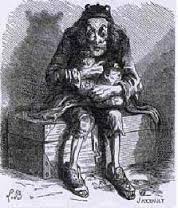
In the Talmud and the New Testament, the word "mammon" means "property", both monetary and property, but sometimes it is personified into a god or demon. "No one can serve two masters: for either he will hate the one and love the other; Or one will be zealous, and the other will not be pleased. You can not serve God and Mammon "(Matthew 6:24). For kabbalistic and Christian magicians, it was common to deduce the names of angels from the functions and responsibilities described in the Scriptures, so it is not surprising to create a demon of Mammon from the biblical context. Mammon, as a demon of wealth and greed, found his face only in the Middle Ages. The nun of St. Francis (1384-1440), who had visions, placed Mammon in a row of three princes of hell, subordinate only to Lucifer. "The first of these is Asmodeus, once a cherubim, but now he knows carnal sins. The next one is Mammon, a demon of greed that" sits on the throne "of this world. The third is Beelzebub, the administrator of idolaters. These three forces and Lucifer never leave their place of imprisonment, except by a special permission from God, but they have legions and legions of subordinate spirits on earth who are responsible to them. " Judging by the extent to which Mammon is doing well today, one can not doubt that the holy nun made a few mistakes regarding his whereabouts, and this demon did not even think of leaving the land.
29. MARHOCIAS - MARCHOCIAS
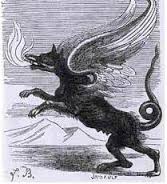
"Goetia" describes the demon Marhosias (or Marhosias) as follows: "He is a great and mighty Marquis, who is at first in the form of a wolf with the wings of a griffin and the tail of a snake spewing fire from the mouth. But after a while, on the command of the caller, he takes on the face of a man. And he is a strong fighter. He is from the Order of Dominion. He obeys 30 legions of spirits. He told his master, who was Solomon, that in 1,200 years he was going to return to the Seventh Heaven. "McGregor Mathers, leader of the Golden Dawn, prepared for publication" Goetia "and added an interesting link to the description of this demon. "In one of the ancient manuscripts of the XVII century, very poorly written, you can read the" wolf "instead of the" wolf ". Mathers' manuscript was published by Alistair Crowley, who made an addendum to this footnote: "To me he is always in the form of an ox and at the same time very numb." Clearly, Crowley had in mind Mathers himself, his former teacher (such humor is typical of Crowley, who could not resist a flat joke or pun), but it is possible that in his youth, during training in the "golden dawn", Crowley experimented with Call the majority, if not all, of the demons described in the "Goetia". His mentor in the "Golden Dawn", Allan Bennett, somehow accused him that he "deals with" Goetia "unprofessional."
30. Mephistopheles - MEFHISTOFHELES
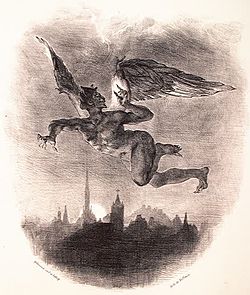
The most famous, though not the most revered and far from the most powerful demon, largely due to his fame is the talent of the poet Johann Wolfgang Goethe and the composer Charles Gounod, Mephistopheles (Mephistopheles), according to legend, served as a "acquaintance" to a German vagrant scientist and Magician, George (Joannes) Sabillicus Faust (1480-1540?). The name of this demon is written in different ways, including Mephistopheles, Miphostophiles, Mephisto, Mephostophiles and Mephistophilis. Perhaps the Greek. Origin - "hating light", from me, phos - light and rhholos-loving; On other versions, the ancient Hebrew. Origin - from mefits - destroyer and tofel - liar. Folklore and fiction of different countries and peoples often used the motive for concluding an alliance between the demon - the spirit of evil and man. For the first time this literary character appeared in the German folk book "The Story of Doctor Faust ..." (published in 1587), then he became the hero of the philosophical drama "Faust" by IV Goethe and other works (in the 20th century he inspired Pushkin and Dostoevsky ("The Brothers Karamazov"), in the 20th century T. Mann novel "Doctor Faustus"). Everywhere he acts as a companion and tempter of Faust, offering him power, knowledge, earthly goods in exchange for the soul. Dr. Faust is the hero of German folk legends and works of world literature and art, a symbol of human striving for knowledge of the world. However, there is sufficient convincing evidence that Faust actually lived and practiced magic, although there is no evidence that he sold the soul to Lucifer or communicated with a demon named Mephistopheles. Living in Germany, he was known throughout the country as a fraud and a crook. The great occultist Abbe Tritemius, who knew the Faust personally, spoke of him judgingly. Fedor Ivanovich Shalyapin created an unforgettable image of Mephistopheles in opera.
31. Moloch - MOLOCH

Moloch is another deity mentioned in the Old Testament. "Moloch" in Hebrew means "king". The Babylonians worshiped this deity, forcing their children - both girls and boys - to ritually go through the fire (The Second Book of the Kings 23:10). It was the usual form of purification and initiation, used in pagan times in honor of many gods. Apparently, this god was popular: the Israelis were explicitly forbidden "idolatry with Moloch", i.e. Give his seed to Molech or offer his children to him (Lev. 20: 2-5). Anyone who violated this order had to be killed by his neighbors. The historical point of view was that the children were burned alive as a sacrifice to Moloch. This is absolute nonsense, and it is difficult to understand how this ridiculous idea could survive for so many centuries in an unchanged form. The usual tradition of passing a fire was to jump over a fire. This demon is portrayed as an ugly creature, with a face smeared with blood, his main pleasure is to drink mother's tears.
32. Nybras-NYBRAS

The lowest demon, who was responsible for the entertainment of demons in hell - he can sympathize. As to the nature of these entertainments, we can only guess, but we believe that no human vices to these creatures are alien and even beyond that.
33. Nebiros - HEBIROS
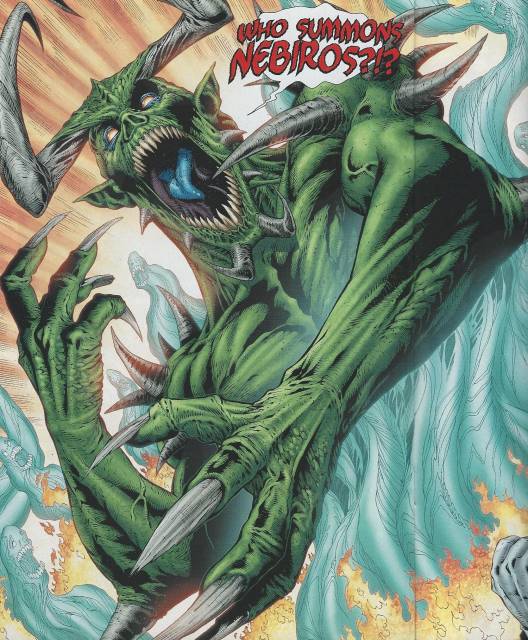
Nebiros is one of the lower demons of hell. His portrait in the "Red Dragon" connects the body of the caterpillar with the child's head. It is accompanied by a picture of the sheet. This suggests that Nebiros could have some power over diseases carried by insects, or influence the spoilage of crops by insects. E. Waite linked the image of Nebiros with Ful, the spirit of Monday, and the Moon.
34. Pan-RAI
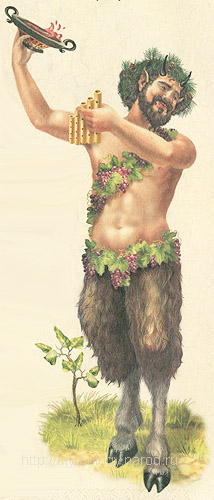
Pan was an ancient Arcadian shepherd's god defending herds, flocks of domesticated birds and hives. He also sent the hunters to the prey. According to legend, he had a human body with a beard, hairy legs, horns and goat ears. Sometimes he was portrayed with a short fluffy tail. His lean face constantly reflected a lascivious, carnivorous look. In the evenings, Pan enjoyed mountain nymphs, and in the daytime slept in a cave after a spree. He liked to boast that he copulated with all maenads, nymphs, companions of the god of wine Dionysus. He also seduced Selena, the goddess of the moon, by hiding her dark goat hair under a freshly washed light rune. Robert Graves lovingly calls him "a shameless old arcade god with goat legs" ("The Greek Myths", vol. 1, Section 21-c). In the Middle Ages, the legend of the death of Pan (Francois Rabelais "Gargantua and Pantagruel") was widespread.
35. Pazuzu - PAZUZU

Pazuzu is a relatively inconspicuous Sumerian plague demon, especially the hot southeasterly winds that carried this illness. In our time he would remain almost unknown, if not for the irony of fate. This demon was chosen for the role of a star in the sensational film "Exorcist." It was Pazuzu who moved into a little girl and made her head rotate 360 degrees, he was the cause of all the troubles that she had to endure during the film. I understand that Pazuzu received a percentage of the profits of the "Exorcist" and has since moved to the tropical regions of hell to avoid taxes that his old friend Mammon imposed on him. But this is only a rumor. Pazuzu is characterized by four wings, a lion's head and paws and a human body. The illustration does not show the tail of the scorpion. He has power over the plague carried by the winds, can bring it or divert it. The small statuette shown in the illustration was found in the Sumerian ruins facing south-east, presumably to lead away the evil south-east winds.
36. Phoenix - RENOIL1X

Usually we do not associate a phoenix with demons. Phoenix is a mythical bird, known in ancient times for its immortality. According to the legends, she resembled an eagle with red and gold feathers and a star on her forehead. Greek writers, beginning with Herodotus, tell of the sacred Egyptian bird that looks like an eagle arriving every 500 years (according to Pliny - 540, according to Martsial - 1000, etc.) from Arabia to Iliopol for burial in the temple there Ra of his father, Enclosed in an egg. According to Epiphany, Svid, and others, Phoenix himself flies to die in Iloli. Here it is burned in incense; From the ashes it revives again, first in the form of a caterpillar, which on the third day begins to turn into a bird and on the 40th it becomes definitive and flies home to Arabia. The occasion for these stories gave rise to the existence in Iliopol of a bird of Benn, dedicated to Ra, the god of the sun, coming from the east, dying every evening and resurrected every morning. As a symbol of resurrection, Phoenix was also considered a consecrated Osiris and was called his soul. In Iliopol was a temple called Ha-ben, ie, "Phoenix Temple"; There was a sacred tree on which he sat and on the leaves of which the gods recorded the royal jubilees; On him he was born in the morning in the midst of incense and flame. In Tanis, Phoenix was revered as the bird of Osiris. In addition, he was honored in Diospol small, near which was the island of Ta-benni (Tabennh) - "phoenix" - the foundation of the first monastery. There are several versions of how the phoenix revived. The Roman poet Ovid argues that after living 500 years, the bird builds a nest of rare spices on top of a palm tree or a stone oak, lies down in it and dies. From her body rises the phoenix chick, who will live another 500 years, before again reborn to life. Then the young bird referred the nest and corpse of the old bird to the city of Heliopolis in Egypt and left them at the door of the temple of the sun god, Helios. The corpse, wrapped in spices, was burned on the altar of Helios. One of the variants of this legend says that the old phoenix beating his wings on the altar of Helios, as a result of which his body flared up and turned into ashes. From the ashes rose the young same bird. In another version, it is said that when an old bird died in a nest, a white worm appeared from its decomposing corpse, which grew into a new phoenix. Due to its ability to return to life, the phoenix has become a symbol of the great works of alchemy, which in the understated sense is the transformation of simple metals into gold, and in the highest sense - the transformation of mortal man into an immortal superman. Inclusion of Phoenix in the catalog of demons clearly shows that in the Middle Ages superstitious Christians considered all the fabulous or strange creatures from classical myths as devil and wicked. The beautiful spiritual aspect of the legend about the phoenix was discarded almost completely, although the echo of it exists in the "Goetia" in the notes on the demon Phoenix and his hope to return to heaven. "Goetia" puts Phoenix as the thirty-seventh of 72 demons imprisoned in a bronze vessel with the seal of King Solomon. "He is a great marquis and is in the form of a Phoenix bird, which has the voice of a child. He sings in front of many beautiful songs that he does not need to notice, but little by little he must ask him to take the form of a person. Then, if necessary, he will speak with amazing words about all the wonderful sciences. He is an excellent poet. And he will gladly fulfill all the requirements. He also has the hope of returning to the Seventh throne in another 1,200 years, as he told King Solomon. He controls 20 legions of spirits. "
37. Ronve - RONWE

Ronve is one of the younger demons who provides knowledge in foreign languages. The stick that is carried under the arm is probably designed to beat the lazy disciples. He has the look of a real teacher, and he reminds the author of some of his old teachers. This demon can be a demon named Ronova, mentioned in Goetia and Discoverie of Witchcraft by Reginald Scott, who says: "Ro-nova is a marquis and a count, he looks like a monster, he brings unique knowledge of rhetoric, loyal servants, Benevolence of friends and enemies. He obeys 19 lefthons of ghosts. In past centuries the word "monster" was applied to disfigured people, such as the famous elephant man. In this sense, in the "Infernal Dictionary" by Collin de Planci, Ronve's look is disfigured.
38. Satan - SATAN
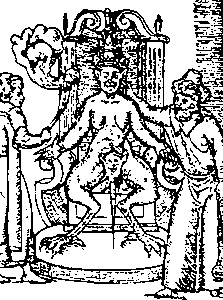
In modern Western culture, as a rule, do not distinguish the devil from Satan and Lucifer. These names are viewed as different aspects of the same being, the devil. But even in this case it will be useful to distinguish between them, since this will help to fully define the nature of the ruler of hell, as it is understood in the folklore of European Christians for over a thousand years. The word "devil" comes from the Greek diaballein - "slander, defame". Hence the devil is a great deceiver, putting obstacles on the way of mankind. The name Lucifer comes from the Latin "bringing light, bringing light" (see above). This was the name of angela, who led the rebellion against God and was cast into the nether world as punishment for wanting to become independent. Lucifer was the Devil's name when he was still an angel ... However, having headed the underworld, he took the name (or title?) Of Satan. But the biblical "Book of Job" directly proves that Satan was among the angels before the insurrection: "And there was a day when the sons of God came to stand before the Lord, and Satan came between them. And the Lord said to Satan, "Where did you come from?" And Satan answered the Lord, and said: I walked on the earth and went around it "(Job 1: 8).
39. Satanahiya - SATATiACHIA
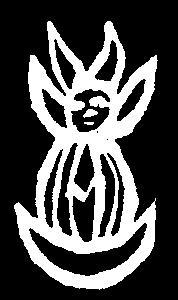
In the Red Dragon, Satanachia (Put Satanachia) is represented as the great general of hell. His image is the most amazing among all demons. He sits inside the crescent, his body is covered with a shell, another crescent is behind his head. It can be either some kind of flower, or some kind of unprecedented insect. It is difficult to determine what. It is necessary to remember the above remark of Francis Barrett: if a demon has great power, he appears in the guise of a person. Demons, which are in the form of animals, have less power. Even lower demons are in the form of insects or plants. The most unintelligent are demons in the form of objects. Satanahiah is titled as general-anshefa, it is believed that he possessed a profound knowledge of all the planets and commanded all earthly matters, he also helped the demons to establish a close relationship with people living on earth.
40. Urobach - UROBACH
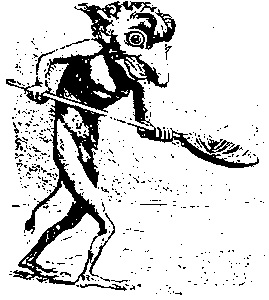
Collin de Planci illustrates Uroba-ha with a night pot filled with hot coals, presumably in order to roast sinful souls in hell. He is all - ears, nose, eyes and mouth, which indicates the sharpness of feelings, to savor the torment of his victims. This creature can be the same as the Orobas demon, mentioned in Goetia and Discoverie of Witchcraft by Reginald Scott. The latter says this demon: "Orobas is a great prince, he is in the form of a horse, but when he puts on a human face, he speaks of heavenly virtue, OH gives truthful answers to questions about the past, present and future, talks about virtue and creation Peace, does not deceive or tempt anyone. He gives dignity, favor of friends and enemies and rules the twenty legions. "
Ritual murders and sacrifices of Jews
Blood, betrayal, torture and, finally, capitulation intertwined in the fate of the Italian Jew, Dr. Ariel Toaff. He and his story could have come down from the pen of his compatriot, Umberto Eco. Dr. Toaff made a discovery that horrified him, but he courageously continued the work begun. Then the Jewish community exerted such a strong pressure on the scientist that he was broken and forced to repent and renounce. It happened not in the Middle Ages, but nowadays.
Ariel Toaff was born into the family of the chief rabbi of Rome. Professor of the Jewish religious university Bar-Ilan, which is not far from Tel Aviv, he gained fame through a fundamental study of the medieval history of the Jews. Toaff's three-volume work "Love, Labor and Death" (subtitles: "The Life of Jews in Medieval Umbria") is a real encyclopedia on this rather narrow topic. Working on the book, the scientist discovered that the medieval communities of the Ashkenazim Jews in northern Italy practiced a particularly brutal form of human sacrifice. Sorcerers and their accomplices abducted and killed Christian babies, and their blood was used in magical rituals, seeking to bring the spirit of revenge upon the hateful goyim.
It would be much easier to condemn the book if its author was a Christian. One could brand the scientist for anti-Semitism. One could ignore the radical Jews of the Diaspora, who not only attack Israel's policies, but sometimes even question its right to exist. You can just call them self-haters. But everything becomes much more difficult when a Jewish scholar from a Jewish religious university raises a topic that causes primitive fears among Jews.


Comments
When commenting on, remember that the content and tone of your message can hurt the feelings of real people, show respect and tolerance to your interlocutors even if you do not share their opinion, your behavior in the conditions of freedom of expression and anonymity provided by the Internet, changes Not only virtual, but also the real world. All comments are hidden from the index, spam is controlled.